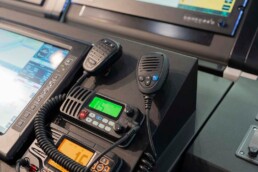Introduction to UHF Radios in Geospatial Applications
When working in remote areas, reliable data transmission is not a luxury—it’s a necessity. UHF (Ultra High Frequency) radios have become a critical tool in geospatial applications, offering the ability to transmit data over long distances without depending on existing infrastructure. Whether you’re conducting land surveys, mapping terrain, or monitoring environmental conditions, UHF radios ensure that data is transmitted accurately and efficiently, even in the most challenging environments.
Unlike standard communication tools, UHF radios are specifically designed for rugged, real-world conditions. They operate on frequencies that penetrate obstacles like dense vegetation, rough terrain, and even urban structures, making them ideal for projects in isolated or difficult-to-access locations. This adaptability allows you to focus on your work without worrying about interruptions in communication or data loss.
Challenges of Data Transmission in Remote Areas
Remote environments bring a unique set of challenges that can disrupt data transmission and affect the quality of your results. Mountains, forests, and large bodies of water often create signal interference, making traditional communication methods unreliable. Even when infrastructure like cell towers is present, coverage gaps and weak signals can severely limit your ability to send and receive critical information.
Another major issue is the sheer distance involved in many remote projects. Surveying or mapping across vast tracts of land often requires communication over extended ranges, far beyond the capabilities of standard devices. These challenges aren’t just inconvenient—they can delay projects, increase costs, and compromise accuracy, which is why having a dependable solution like UHF radios is so important.
UHF radios address these issues by offering robust performance tailored to the demands of remote operations. Their ability to deliver consistent, high-quality data transmission ensures you can overcome the obstacles of distance and difficult terrain, keeping your project on track and your results accurate.
Advantages of UHF Radios for Remote Data Transmission
When precision matters, UHF radios stand out as an essential tool for reliable communication. One of their biggest advantages is their ability to transmit data over long distances with minimal interference. Whether you’re working in rugged mountainous regions or expansive open fields, UHF signals have the strength and resilience to maintain consistent communication. This is critical in ensuring real-time data transmission without delays, which can be the difference between a successful project and costly setbacks.
Another strength of UHF radios is their capacity to penetrate physical obstacles like dense vegetation, rocky terrain, and even urban structures. Unlike other transmission methods, UHF operates on frequencies that handle environmental challenges with ease. This makes them invaluable in industries such as construction, mining, and geospatial surveying, where the terrain often works against you.
Power efficiency is another significant advantage. UHF radios are designed to perform reliably on lower power, making them ideal for field operations where access to continuous power supplies is limited. Their durability in harsh conditions, combined with their efficiency, ensures that you can rely on them for uninterrupted operation throughout your project.
Integration of UHF Radios with GNSS Equipment
The synergy between UHF radios and GNSS equipment takes precision and efficiency to the next level. UHF radios play a vital role in facilitating real-time kinematic (RTK) corrections, which are essential for achieving centimeter-level accuracy in GNSS surveying. By transmitting correction data seamlessly between a base station and a rover, UHF radios ensure that your positioning data remains accurate, even in challenging environments.
This integration is especially useful in applications where reliability is paramount. Whether you’re conducting a cadastral survey or mapping remote terrain, the combination of UHF radios and GNSS systems eliminates the risk of data loss or inaccuracies caused by delayed transmissions. The result is a more efficient workflow, with fewer interruptions and greater confidence in your results.
What sets UHF radios apart is their compatibility with a wide range of GNSS systems, allowing you to customize your setup based on your specific project requirements. With a properly integrated system, you can tackle even the most complex geospatial tasks with the precision and reliability needed to deliver outstanding outcomes.
Canal Geomatics’ UHF Radio Offerings
When it comes to UHF radios, having access to reliable, high-performance equipment is essential for success in remote operations. Canal Geomatics offers a range of UHF radio models tailored to meet the demands of geospatial applications. Their selection includes cutting-edge options designed for seamless integration with GNSS systems, ensuring accurate data transmission even in the most challenging environments.
For example, models like the JAVAD HPT404BT offers exceptional signal strength and durability, making it an ideal choice for fieldwork in harsh conditions. With these options, you can choose a solution that matches your project’s specific needs, whether it involves short-range communication or extended distances over rugged terrain.
Beyond the hardware, Canal Geomatics ensures that every product is backed by expert support. From helping you select the right model to offering troubleshooting advice, our team is dedicated to helping you get the most out of your UHF radios. This combination of quality products and reliable service makes us a trusted partner for professionals in geospatial industries.
Case Studies: UHF Radios in Action
UHF radios have proven their value in countless real-world applications, delivering reliability and precision in remote environments. In one geospatial project focused on environmental monitoring, teams relied on UHF radios to transmit real-time data from sensors placed across a dense forest. The radios maintained a stable connection, even in areas where natural obstacles like thick tree canopies and uneven terrain would have disrupted other communication systems.
Another notable example comes from a large-scale construction project where UHF radios facilitated communication between GNSS-enabled machines and their operators. This setup ensured that grading and excavation tasks were executed with centimeter-level precision, saving time and minimizing material waste. The ability to maintain reliable data transmission over vast construction sites significantly improved project efficiency and reduced costs.
In mining operations, UHF radios have been used to monitor and control autonomous vehicles navigating hazardous terrains. These radios enabled continuous communication, ensuring safety and operational efficiency in an environment where failure is not an option. These case studies highlight the transformative impact of UHF radios across industries, emphasizing their importance for remote data transmission.
Best Practices for Implementing UHF Radios
To maximize the performance of UHF radios in remote data transmission, proper implementation is crucial. Start by selecting a radio model that suits your specific project requirements. Factors such as frequency range, power output, and environmental durability should guide your choice. For example, high-power radios are better suited for long-range communication, while compact models may be more practical for smaller, localized operations.
Proper frequency selection is another key consideration. Be aware of local frequency regulations to ensure compliance, and choose a channel that minimizes interference from other devices. Configuring your UHF radios to match the operating conditions can also enhance signal stability, particularly in areas with challenging terrain or heavy vegetation.
Maintenance and regular health checks are essential for ensuring consistent performance. Check antenna connections, inspect for physical damage, and update firmware as needed. Training your team on the proper use and troubleshooting of UHF radios can prevent downtime and ensure a seamless workflow. Following these best practices helps you leverage the full potential of your UHF radios for reliable data transmission in any environment.
Future Trends in UHF Radio Technology
UHF radio technology is evolving rapidly, with new advancements enhancing its capabilities and expanding its applications. One key trend is the integration of digital communication protocols, which improve data security and reduce signal interference. These protocols also allow for more efficient use of bandwidth, enabling clearer and faster data transmission, even in congested frequency environments.
Enhanced durability and power efficiency are also becoming standard features, making UHF radios more reliable for long-term field use. As technology continues to advance, you can expect UHF radios to play an even larger role in geospatial applications, enabling more precise, efficient, and sustainable operations.
How UHF Radios Shape Remote Communication
Reliable data transmission in remote areas is a cornerstone of success for geospatial and other precision-driven industries. UHF radios have established themselves as an indispensable solution, overcoming challenges like difficult terrain, extended distances, and infrastructure limitations. By offering robust performance, seamless integration with GNSS systems, and adaptability to future technological advancements, UHF radios ensure you have the tools you need to succeed in even the most demanding environments.
This article highlights their transformative impact across various applications and industries. If you’re looking to enhance your data transmission capabilities, understanding and leveraging UHF radio technology will undoubtedly set you apart in achieving precision and efficiency.

